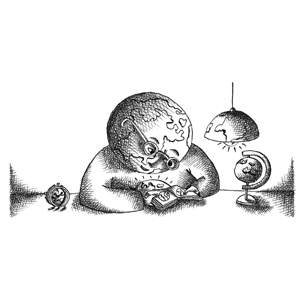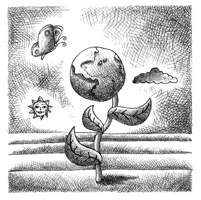In this chapter:
- A Historic Perspective
- First in Command: Prof. Mordeckai Magaritz (1944-1993)
- Environmental Science Students Take the Stage
- Building with Energy
- Early Achievements

Over the years, Weizmann Institute studies in the Environmental Sciences and Energy Research Department, as well as environmentally relevant projects in other departments, have grown into a far-ranging effort aimed at extending the frontiers of knowledge and preserving the magnificent, irreplaceable environment of the planet on which we live. We offer here a brief history of the Institute’s environmental studies and a look at the future generation of environmental researchers trained at Weizmann. Then follows a description of the Sussman Family Building for Environmental Sciences, which serves as a model for the introduction of energy-saving technologies throughout Israel.
A Historic Perspective
Environmental research at the Weizmann Institute was born together with the State of Israel, under rather unusual circumstances. In the late 1940s, a number of prominent professors from around the world were invited to move to Rehovot to head new scientific departments at the fledgling Institute. But just then Israel’s War of Independence broke out, most scientific luminaries canceled their trips, and young, primarily local researchers found themselves running the Institute. Driven by concern about the future of the country, they initiated studies of paramount importance to Israel’s national needs, including research that later became known as the study of the environment.
One of these unwitting scientific leaders was Israel Dostrovsky, who joined the Rehovot faculty in 1948, a year before the dedication of the Weizmann Institute, and became the founder of isotope research at the Institute (and in Israel as a whole) at the age of 30. “I think it was a unique example in history when novice scientists were given an opportunity to found entire research departments - and most of those departments succeeded,” he says.
Under Dostrovsky’s direction, the Institute’s Isotope Research Department became a world leader in its field. Isotopes are varieties of an element that share its chemical properties but differ in weight. In the late 1940s, a facility was established on campus for the separation of oxygen isotopes, which were used as tracers for studying complex phenomena in nature and for monitoring processes in the human body during medical diagnosis. The Department’s heavy oxygen isotopes became export items that earned the Weizmann Institute several millions of dollars and supplied a large proportion of world demand for many years.
Institute scientists not only conducted theoretical studies on the properties of isotopic molecules but also explored their practical applications. Already in the 1960s, they started applying isotopes to the study of water, one of the region’s most ancient problems and still one of the most urgent. This research, led at that time by Profs. Aharon Nir and Joel Gat, Dostrovsky’s former students, covered the entire hydrological cycle of the eastern Mediterranean region, including studies on underground water resources, the Jordan River, and the Dead Sea. One important direction was a reconstruction of the environment that prevailed in the region in ancient times, based on an analysis of lake sediments, tree rings and millenia-old water from deep boreholes in the Negev. A major highlight was the establishment of the first radiocarbon dating laboratory in Israel, which continues to support both the hydrological and the archaeological research around the country.
In other studies relevant to the environment, Institute scientists provided laboratory backing for geological surveys and sought to advance desalination, a potential solution to the region’s water shortage.
Meanwhile, several of Dostrovsky’s students followed in his pioneering footsteps, establishing new research areas involving isotopes at the Institute. By the end of the 1980s, projects in the Isotope Research Department grew so diverse that a decision was made to reorganize the research by topic rather than by method. By then, the study of the environment had evolved into a separate academic field, and in 1990 a special Institute committee recommended establishing the Environmental Sciences and Energy Research Department. It incorporated all isotope projects having to do with hydrology and other environmental topics. Other projects were distributed among appropriate departments: today’s brain research, magnetic resonance imaging and scientific archaeology are all indirect outgrowths of the Institute’s initial work with isotopes.
It was natural for the newly founded environmental studies department to incorporate solar research, another Dostrovsky brainchild. Convinced that Israel should “go solar,” he persuaded the Institute to invest in a multimillion-dollar solar research installation. Fueled in part by collaborative projects with industry, the facility soon became engaged in one of the most advanced solar research programs in the world (see pp. 35-49).
First in Command: Prof. Mordeckai Magaritz (1944-1993)
Prof. Mordeckai Magaritz, first head of the Environmental Sciences and Energy Research Department, came to the Weizmann Institute in 1969 to pursue doctoral studies after receiving a B.Sc. and M.Sc. in geology from the Hebrew University of Jerusalem. Prof. Joel Gat says he felt more like Magaritz’s research collaborator than his Ph.D. adviser: Magaritz did his doctorate in geochemistry, combining his prior knowledge of geology - a subject as yet unexplored at Weizmann - with the isotope methods he learned at the Institute. He then held several positions in Israel and in the United States before assuming a research post in Weizmann’s Isotope Research Department in 1977.
A big, bearded, gregarious man, Magaritz was known for his boundless energy and for caring more about research than about formalities and status. Gat recalls finding him early one morning in the laboratory washing experimental dishes, a job normally done by lab technicians. Magaritz explained that it took the technicians two hours each morning to do the dishes; by getting the chore out of the way before the technicians arrived, he could advance the start of the experiments.
Magaritz probed the past and present changes in Earth’s environment by measuring the concentrations of stable isotopes in soil and water. One of his innovations was the application of isotopic techniques to agriculture. In other projects, he performed isotopic measurements to study variations in the Middle East climate over the preceding 20,000 years in order to anticipate future climate shifts.
Research into coastal aquifers, including the risk of seawater intrusion, was another topic that attracted Magaritz’s attention. He showed that increased pumping of fresh water from underground reserves - a tempting prospect in times of water shortage - could inflict irreversible damage. Working with Dr. Dan Ronen, then of the Israel Hydrological Service, Magaritz invented a multilayer tester for examining the content of ground, reservoir and lake water at different depths.
Magaritz was instrumental in the establishment of the Institute’s Environmental Sciences and Energy Research Department in 1990, but he was to hold the position of department head for barely three years: he died in 1993 at the age of 49, eight months after receiving a heart transplant. “He had an amazing breadth of vision and tried to enroll all possible means to protect the quality of the environment in which we live,” said Prof. Haim Harari, then President of the Weizmann Institute, in his eulogy.
At the beginning of every year, the first seminar of the Environmental Sciences and Energy Research Department, held in the Mordeckai Magaritz Seminar Room of the Sussman Family Building for Environmental Sciences, is dedicated to the memory of the department’s first head.
Environmental Science Students Take the Stage
A conference of the students for the students - that’s the essence of CARESS, the scientific meeting held at the Weizmann Institute every two years since 1998. The Conference on Active Research by Environmental Science Students is a special forum where students from different academic institutions in Israel present their work, learn about research at other institutions and exchange ideas. Each conference is organized by student members of the Institute’s Department of Environmental Sciences and Energy Research, and all the scientific talks are given by students.
The idea is to expose students to a broad range of topics in environmental research, beyond the narrow scope of their own field of study. While it is the veteran researchers who do most of the talking at large scientific gatherings, an all-student conference provides for a less formal atmosphere in which researchers-to-be are more free to express themselves and interact with one another. For B.Sc. and M.Sc. students, the CARESS conferences also provide an opportunity to glean ideas for their further studies.
The topics discussed at CARESS conferences reflect the full spectrum of environmental studies in Israel - from climate change to environmental pollution to the modeling of atmospheric systems. Many of the talks focus on environmental issues of specific interest to Israel, particularly the management of water resources, one of the region’s most acute concerns. Generally, some 40 students from all over Israel present their research in lectures and poster sessions; a keynote address is delivered by a prominent invited speaker.
Organizers of CARESS conferences speak of the benefits they personally derived from the all-student gatherings. Simon Emmanuel, an immigrant from the United Kingdom, says that while attending one of the CARESS meetings he got new ideas for his M.Sc. research thesis. Emmanuel is currently working toward a doctorate examining hydrothermal systems in which circulating ocean water comes into contact with hot rock rising from the Earth’s mantle; his Ph.D. adviser is Prof. Brian Berkowitz. Kadmiel Maseyk, a student from New Zealand, says attending the CARESS conferences helped him gain new perspectives on the methods used in his own field. Maseyk’s doctoral research, guided by Prof. Dan Yakir, focuses on the exchanges in carbon dioxide between plants and the atmosphere.
In the preface to one of the latest conference programs, the organizers expressed their hope that the CARESS scientific meetings “will continue to serve as a valuable forum for the exchange of ideas among students researching topics of environmental significance.”
Building with Energy
Visitors from all walks of life are drawn to the Weizmann Institute’s verdant campus, but the Sussman Family Building for Environmental Sciences attracts a special kind of guest. Engineers trained to be energy supervisors come to tour the building - the first public structure in Israel to be termed “environmentally friendly” -as part of the course given by the Energy Conservation Department of Israel’s Ministry of National Infrastructures.
Erected in 1996, the Sussman Building has become a model for the introduction of energy-saving technologies on university campuses and industrial sites throughout the country. Thanks to such technologies, running the building requires two-thirds of the energy per square meter needed by similar research facilities that lack those features.
What has earned the Sussman Building the title “environmentally friendly”? Among its numerous design elements intended to cut electricity expenditure, a major role is that of controlled fume hoods. While a standard hood - a ventilation system with an exhaust pipe that removes noxious fumes from the air - operates non-stop, a controlled fume hood has “smart” sensors that turn it on only when necessary. The result is an enormous cutback in energy, achieved without jeopardizing the workers’ safety: while a regular hood removes on average 1,100 cubic feet of air per minute, a controlled hood in the Sussman Building removes 400 cubic feet per minute; air conditioners, in turn, have “smart” valves that let in fresh air on an as-needed basis (i.e., only when the hoods are operating), thus preventing an overtaxing of the air-conditioning system. Following the example of the Sussman Building, such controlled fume hoods have been installed in other buildings on the Weizmann campus as well as at other academic institutions and industrial buildings in Israel.
Another major energy saver is a humidity-reducing installation that chemically dries the air before pumping it into the air-conditioning unit, thus cutting the need for cooling by almost half.
Other energy-saving features include: improved thermal insulation; outside grids that provide shade; ceiling fans that create a cooling breeze in the summer and prevent hot air from accumulating near the ceilings in the winter; and sophisticated use of natural light, including large windows and skylights, as well as special window shades and Venetian blinds that direct the light to different parts of the room. The building, along with the rest of the campus, is monitored via a computer so that breakdowns are instantly detected and fixed, preventing energy waste.
As a result, the funds invested in the Sussman Building’s energy conservation features promise to pay off in the long term. In 2001, for example, the building’s annual energy consumption per square meter was 210 kilowatts per hour, compared with 310 kilo-watts per hour in a non-environmentally friendly research building. For the entire Sussman Building, whose area is 2,500 square meters, this means cutting energy expenditure by 25,000 kilowatts, a saving of $20,000 a year.
Environmentally friendly buildings are particularly valuable in Israel, where both heating in the winter and cooling in the summer are expensive. To quote Israel’s largest daily, Yedioth Ahronot: “The problem is on a national scale: most buildings in Israel are fiercely hot in the summer and bone-chillingly cold in the winter. Why? Because of faulty design that fails to take into account the climate, the environment, and of course, the tenants. Today, energy-conserving buildings such as the Sussman Building are considered to be a principal contribution to the environment and to the quality of life.”
Early Achievements

A superconductor with potential industrial applications has been “cooked up” in the Institute’s Rowland and Sylvia Schaefer Solar Research Complex. The scientists, headed by Prof. Shimon Reich of the Materials and Interfaces Department, made use of a solar beam concentrated to 11,000 times the intensity of natural sunlight reaching the Earth. The ceramic superconductor prepared with the help of this clean and fast method may one day be used to build a variety of improved mechanical devices - such as frictionless ball bearings that never need oiling, efficient magnetic dampers to reduce mechanical vibrations, and magnetic clutches with no direct contact between the clutch plates.
Prof. Emeritus Yehuda Mazur of the Weizmann Institute’s Organic Chemistry Department cooperated with Dr. Aurel Acher of the Agricultural Research Organization - Volcani Center in Beit Dagan to investigate the use of solar energy for disinfecting wastewater. The method employs an organic dye called methylene chloride, dissolved in the water. When the water is exposed to sunlight, a powerful oxidizer, “singlet oxygen,” is produced. The singlet oxygen kills unwanted microorganisms without forming dangerous byproducts - in contrast to chlorination, the widely used method of disinfecting water, which releases large amounts of chemicals into the environment. Scientists have successfully applied the new method in hydroponics. The technique, which is applicable in a dry climate, is currently in use in the Jordan Valley.
In photosynthesis, plants use sunlight to convert carbon dioxide and water into sugars. In nature, however, the overall productivity of this process is often limited by the relatively low intensity of light intercepted by plants. Profs. Dan Yakir and Amnon Yogev of the Environmental Sciences and Energy Research epartment have developed an approach for enhancing photosynthetic productivity by means of concentrated sunlight. For example, they have succeeded in increasing the production of beta carotene by the saltwater alga Dunaliella. The alga manufactures beta carotene, which is commonly used as a food suppliment, to protect itself from strong sunlight.






















